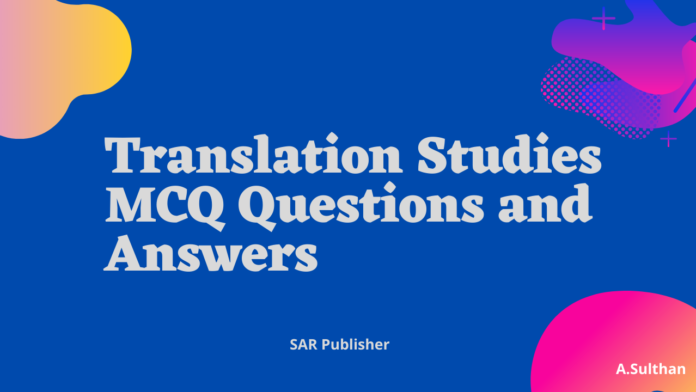Translation Studies MCQ Questions and Answers Part – 1
Translation Studies MCQ Questions and Answers Part – 2
Translation Studies MCQ Questions and Answers Part – 3
51. Catford (1978) divides the shift in translation into_____ major types.
A. nine
B. two
C. eight
D. five
ANSWER: B
52. The Jewish Bible, the Old Testament, was originally written almost entirely in ________.
A. hindi
B. tamil
C. Hebrew
D. norton
ANSWER: C
53. The New Testament, however, was written in _______.
A. latin
B. Greek
C. malayalam
D. hindi
ANSWER: B
54. The Syriac translation is the __________ of the New Testament.
A. Norse translation
B. Greek translation
C. Latin translation
D. Aramaic translation
ANSWER: D
55. _________is the translation of novels, essays, fiction, short stories, comedy, folk tale, hagiography, works
of criticism, science fiction etc.
A. Greek translation
B. Prose-translation
C. Aramaic translation
D. Norse translation
ANSWER: B
56. ________ was the original grand English translation.
A. Bhagavath Gita
B. Bible
C. Wycliffe Bible
D. Cry the peacock
ANSWER: A
57. ____________ refers to the source-language message.
A. Equivalent
B. problem
C. loss
D. recoding
ANSWER: A
58. _____________ refers to the receptor language.
A. cultural
B. source language
C. language
D. Natural
ANSWER: D
59. ________ binds the two orientations together on the basis of the highest degree of speculation.
A. natural
B. Closest
C. equivalent
D. encoding
ANSWER: B
60. ____________ is the process of translating a document that has already been translated into a foreign language back to the original language
A. Aramaic translation
B. Back Translation
C. prose translation
D. greek translation
ANSWER: B
61. Who said ‘poetry is what gets lost in translation’?
A. Robert Frost
B. Wordsworth
C. Dryden
D. James Joyce
ANSWER: A
62. ____________ plays an important role in translation.
A. Country
B. Culture
C. Tradition
D. People
ANSWER: B
63. A translation is not a monistic composition, but an ____________.
A. Analysation
B. Tradition
C. Interpretation
D. Language
ANSWER: C
64. The first category involves the________________ and is component part of literary history.
A. Linguistics
B. Phonetics
C. Translation and Linguistics
D. History of Translation
ANSWER: D
65. Who did the excellent contribution to the Translation Studies?
A. James Joyce
B. Dryden
C. Peter Robinson
D. Robert Frost
ANSWER: C
66. _________ was a poet, translator and professor of English and American Literature.
A. John Denham
B. Robinson
C. Praz
D. Bassnet
ANSWER: B
67. ___________ is said to be untranslatable, or more subtly in a poetic text.
A. Poetry
B. prose
C. drama
D. word
ANSWER: A
68. Albrecht Neubert’s translations are not available in ________________.
A. French
B. Danish
C. English
D. Spanish
ANSWER: C
69. Robinson points out that his own __________ were produced with the operative assumption with the aim in translating poetry and make translations
A. novel
B. short story
C. prose
D. Poetry
ANSWER: D
70. Poetry and Translation adopts a/an __________ creative outlook toward poetry translation.
A. negative
B. pessimist
C. Optimistic
D. wrong
ANSWER: C
71. __________ confidence can be sustained because human situations are analogous.
A. Translation
B. poetry
C. interlingual
D. Intralingual
ANSWER: A
72. Robinson challenges the philosophical underpinnings of translational impossibility poised by thinkers such as _____________.
A. Susan
B. nida
C. Willard V.Quine
D. Robinson
ANSWER: C
73. Which translator tried Dynamic equivalence to translate Homer’s Epic?
A. Nida
B. E.V.Rieu
C. Popovic
D. Levy
ANSWER: B
74. Translation theory tends to be ____________.
A. Dominant
B. Expressive
C. Normative
D. None of the above
ANSWER: C
75. Which translation is also called direct translation or close translation?
A. Free translation
B. Literal translation
C. Word translation
D. Grammar translation
ANSWER: B
76. Language is a guide to ____________.
A. Social reality
B. Self reality
C. Innovation
D. None
ANSWER: A
77. Language is a _______________ system.
A. Innovative
B. Creative
C. De – modelling
D. Modelling
ANSWER: D
78. ___________________ involves far more than replacement of lexical and grammatical item of a language.
A. Pronunciation
B. Linguistics
C. Translation
D. Meaning
ANSWER: C
79. Eugene Nida distinguishes _____ types of equivalence.
A. Two
B. Four
C. Five
D. Three
ANSWER: A
80. ___________ must know the source language and target language.
A. Listener
B. Speaker
C. Translator
D. None
ANSWER: C
81. Untranslatability is possible in ______________.
A. Drama
B. Cultural contexts
C. Prose
D. Grammar
ANSWER: B
82. ________________ is a serious discipline investigating the process of translation.
A. Maths
B. Translation studies
C. Science
D. Lierature
ANSWER: B
83. The two extremes of paraphrase and literal translation is said by_____________.
A. Abraham Cowley
B. T.R.Steiner
C. Dryden
D. John Denham
ANSWER: C
84. Dryden’s views on translation was closely followed by__________.
A. Alexander pope
B. Abraham Cowley
C. John Denham
D. praz
ANSWER: A
85. Translation studies is incomplete without ___________ perspective.
A. Lexical
B. Historical
C. Linguistic
D. None of the above
ANSWER: B
86. The eighteenth-century concept sees the translator as ______or imitator with a moral duty both to his
original subject and to his receiver.
A. musician
B. Painter
C. artist
D. narrator
ANSWER: B
87. Goethe argued that very literature must pass through__________ phases of translation.
A. 7
B. 6
C. 5
D. 3
ANSWER: D
88. Steiner has divided History of translation into ___________ periods.
A. 4
B. 3
C. 5
D. 1
ANSWER: A
89. ‘Shelly as translator’ is written by __________
A. E.V. Rieu
B. Jackobson
C. Timothy Webb
D. Popovic
ANSWER: C
90. Eric Jacobsen claims translation is a ________________ invention.
A. Greek
B. Roman
C. Spanish
D. Latin
ANSWER: B
91. Susan Bassnett is Professor of Comparative Literature at the University of _____________
A. Cambridge
B. Oxford
C. Warwick
D. Norton
ANSWER: C
92. Susan Bassnett (born 1945) is a _____________.
A. novelist
B. clerk
C. manager
D. translation theorist
ANSWER: D
93. Nida was born in Oklahoma City, Oklahoma on __________.
A. November 18, 1914
B. November 11, 1914
C. November 12, 1915
D. November 19, 1919
ANSWER: B
94. In 1943, Nida received his Ph.D. in Linguistics from the ______________
A. University of lovely
B. University of oxford
C. University of cambridge
D. University of Michigan
ANSWER: D
95. Nida has been a _______in the fields of translation theory and linguistics.
A. excellence
B. administrator
C. pioneer
D. manchester
ANSWER: C
96. Nida most notable contribution to translation theory is _____________.
A. decoding
B. Dynamic Equivalence
C. encoding
D. history of translation
ANSWER: B
97. Nida married___________, translator and interpreter.
A. Dr. Elena Fernadez- Miranda
B. holmes
C. andre
D. lefevere
ANSWER: A
98. Nida Found the journal ____________and served as its editor. The journal continues to serve today as a major resource for practical and theoretical treatment of Bible translation issues.
A. The translator
B. The Bible Translator
C. the bible
D. the translation
ANSWER: B
99. Eugene Nida passed away on August 25, ______ at the age of 96.
A. 2008
B. 2006
C. 2011
D. 2007
ANSWER: C
100. Nida had also published a first edition of the _____________, which became a basis for other translators in their work.
A. Bible
B. Quran
C. Greek New Testament
D. old testament
ANSWER: C


